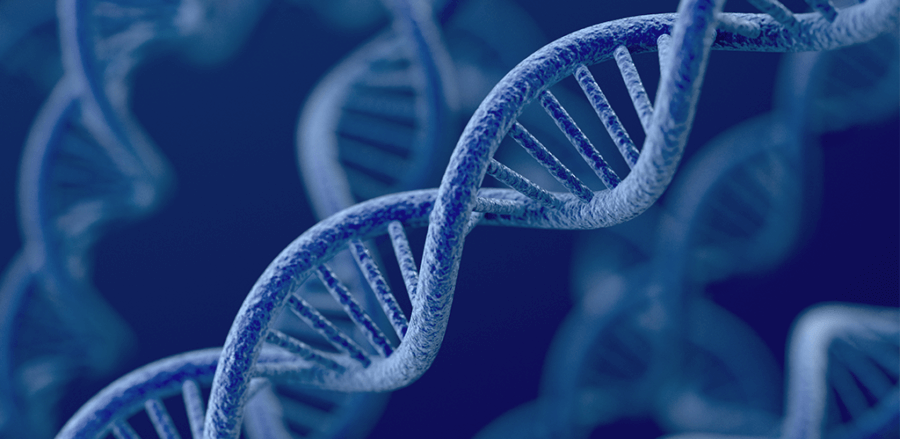Genetic Syndromes: What Are They and How Are They Inherited?

During pregnancy, all women take a diagnostic test to detect possible abnormalities. These tests, in most cases, are negative, but a small number of babies are born with some genetic syndromes.
Hearing the news and facing the reality of the situation is always very hard. In this article, we’ll try to shed some light on some of the questions you may have right now.
What are genetic syndromes?
Genetic disorders are diseases that occur due to genes being altered in some way. Genes are segments of DNA that contain the information to encode a protein. They perform various tasks: they determine the shape of cells, various structural functions, and control almost all metabolic processes.
Proteins are therefore of vital importance in order for our bodies to function properly. However, sometimes a mutation occurs in the genes that will change their “code.” This alteration in the messages they receive when they form will then cause their malfunction. As a result, this can lead to genetic syndromes.
How are genetic diseases or syndromes inherited?
Genes are condensed inside chromosomes. The human species has 46 chromosomes grouped into 23 pairs of homologous chromosomes. The last pair corresponds to the sex chromosomes, which determine the sex of individuals, and the rest we can refer to as autosomal.

We can inherit a genetic mutation from one or both of our parents. Sometimes, though, mutations can occur spontaneously throughout our lives.
During fertilization, each parent contributes a set of chromosomes, a unit from each couple. If an alteration in the groups of chromosomes occurs, then this can pass to the children.
What types of genetic disorders are there?
We should note that sometimes the alteration of the gene doesn’t change the meaning of the message, and its instructions form a functional protein. It may also be the case that only one active copy of the gene, from the mother or father, is needed to make the proteins.
Unfortunately, in the other cases that we’ll see below, the mutation does lead to a genetic syndrome.
- Chromosomal disorders. These occur either when a chromosome from a homologous pair is missing or when there are too many. This phenomenon is known as aneuploidy and the probability of it occurring increases with the age of the woman. An example of this is Down’s Syndrome, in which people have a trisomy (three chromosomes) of chromosome 21.
- Autosomal genetic disorders. These affect one or more genes in the autosomal chromosomes. They’re recessive disorders when both parents carry the mutation. In contrast, when only one of the parents carries the mutated gene, we’re talking about dominant disorders. An example of a dominant genetic syndrome is Huntington’s Disease.
- Sex-linked genetic disorders. These are mutations that are located in the sex chromosomes (pair 23). X-linked hemophilia is one of the most common sex-linked genetic diseases among humans.
- Multifactorial disorders. These affect one or more genes and involve both genetic and environmental factors. Some of these, such as neural tube defects, can be treated surgically.

What tests can I take during pregnancy?
Prenatal genetic testing, while the baby is still in the womb, can give us information about genetic syndromes that our baby may have. Depending on some risk factors such as age or family history, your gynecologist may recommend some additional tests. Of course, these screening and diagnostic tests are voluntary.
The most common tests, apart from the prenatal test in the first trimester, are amniocentesis and the test for genetic abnormalities in the blood.
Amniocentesis involves a puncture of the abdominal wall to remove amniotic fluid and cells from the sac. It can confirm the existence of a mutation with close to 100% reliability. However, it’s an invasive test with a 1% risk of miscarriage.
On the other hand, the test for genetic abnormalities is a non-invasive technique that requires only a small sample of the mother’s blood. It allows the identification of genetic syndromes related to trisomies 21, 18 and 13.
It also allows microchromosome delineations or genetic abnormalities of the sex chromosomes. In most countries, this test is performed by private medical centers.
During pregnancy, all women take a diagnostic test to detect possible abnormalities. These tests, in most cases, are negative, but a small number of babies are born with some genetic syndromes.
Hearing the news and facing the reality of the situation is always very hard. In this article, we’ll try to shed some light on some of the questions you may have right now.
What are genetic syndromes?
Genetic disorders are diseases that occur due to genes being altered in some way. Genes are segments of DNA that contain the information to encode a protein. They perform various tasks: they determine the shape of cells, various structural functions, and control almost all metabolic processes.
Proteins are therefore of vital importance in order for our bodies to function properly. However, sometimes a mutation occurs in the genes that will change their “code.” This alteration in the messages they receive when they form will then cause their malfunction. As a result, this can lead to genetic syndromes.
How are genetic diseases or syndromes inherited?
Genes are condensed inside chromosomes. The human species has 46 chromosomes grouped into 23 pairs of homologous chromosomes. The last pair corresponds to the sex chromosomes, which determine the sex of individuals, and the rest we can refer to as autosomal.

We can inherit a genetic mutation from one or both of our parents. Sometimes, though, mutations can occur spontaneously throughout our lives.
During fertilization, each parent contributes a set of chromosomes, a unit from each couple. If an alteration in the groups of chromosomes occurs, then this can pass to the children.
What types of genetic disorders are there?
We should note that sometimes the alteration of the gene doesn’t change the meaning of the message, and its instructions form a functional protein. It may also be the case that only one active copy of the gene, from the mother or father, is needed to make the proteins.
Unfortunately, in the other cases that we’ll see below, the mutation does lead to a genetic syndrome.
- Chromosomal disorders. These occur either when a chromosome from a homologous pair is missing or when there are too many. This phenomenon is known as aneuploidy and the probability of it occurring increases with the age of the woman. An example of this is Down’s Syndrome, in which people have a trisomy (three chromosomes) of chromosome 21.
- Autosomal genetic disorders. These affect one or more genes in the autosomal chromosomes. They’re recessive disorders when both parents carry the mutation. In contrast, when only one of the parents carries the mutated gene, we’re talking about dominant disorders. An example of a dominant genetic syndrome is Huntington’s Disease.
- Sex-linked genetic disorders. These are mutations that are located in the sex chromosomes (pair 23). X-linked hemophilia is one of the most common sex-linked genetic diseases among humans.
- Multifactorial disorders. These affect one or more genes and involve both genetic and environmental factors. Some of these, such as neural tube defects, can be treated surgically.

What tests can I take during pregnancy?
Prenatal genetic testing, while the baby is still in the womb, can give us information about genetic syndromes that our baby may have. Depending on some risk factors such as age or family history, your gynecologist may recommend some additional tests. Of course, these screening and diagnostic tests are voluntary.
The most common tests, apart from the prenatal test in the first trimester, are amniocentesis and the test for genetic abnormalities in the blood.
Amniocentesis involves a puncture of the abdominal wall to remove amniotic fluid and cells from the sac. It can confirm the existence of a mutation with close to 100% reliability. However, it’s an invasive test with a 1% risk of miscarriage.
On the other hand, the test for genetic abnormalities is a non-invasive technique that requires only a small sample of the mother’s blood. It allows the identification of genetic syndromes related to trisomies 21, 18 and 13.
It also allows microchromosome delineations or genetic abnormalities of the sex chromosomes. In most countries, this test is performed by private medical centers.
All cited sources were thoroughly reviewed by our team to ensure their quality, reliability, currency, and validity. The bibliography of this article was considered reliable and of academic or scientific accuracy.
- INE. Encuesta de Discapacidad, Autonomía Personal y Situaciones de Dependencia 2008.(última consulta abril 2019). Informe Olivenza 2017 sobre la situación general de la discapacidad en España.
- Colegio Americano de Obstetras y Ginecólogos (Mayo 2017). Trastornos genéticos[folleto en web]. Recuperado de www.acog.org
- Colegio Americano de Obstetras y Ginecólogos (Diciembre 2016). Pruebas genéticas de trastornos prenatales [folleto en web] Recuperado de www.acog.org
- Eunice Kennedy Shriver National Intitute of Childrens Health and Human Development. (Ultima consulta abril 2019) Qué pruebas podría necesitar durante el embarazo. Recuperado de NIH: www.nichd.nih.gov
- Medline plus.( última consulta abril 2019). Enfermedades genéticas. Recuperado de : www.medlineplus.gov
This text is provided for informational purposes only and does not replace consultation with a professional. If in doubt, consult your specialist.








